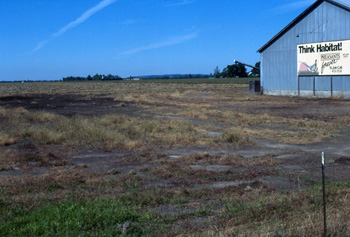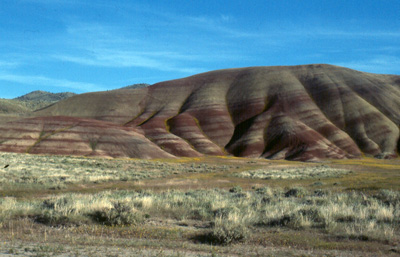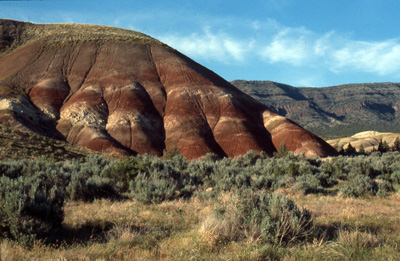WE ARE SQUANDERING THE HERITAGE OF ALL GENERATIONS
Few events in history have been more closely tied to communities than their relations to the soil as the foundation of life. Although terrestrial life drives the continuous exchange of carbon between the myriad soil types and the atmosphere, some forms of soil carbon are more stable and have a longer residence time in soil than others. For example, depending on elevation and soil depth, mineral-associated organic carbon is more stable than organic carbon associated with decomposed remains of plants and animals.1
With global warming, however, the dynamics of carbon sequestration will likely change because climate affects all living organisms by altering their physiology, geographic distribution, and often their longevity. Moreover, responses vary widely across species because they do not respond to extrinsic drivers (such as climate) in isolation of their interactions with other species. Thus, while they either adapt or go extinct when Earth undergoes climatic change, the spatial rearrangement of extant species and the emergence of new lineages provide an ever-novel context within which evolution takes place. Thus, even if the genetic variation necessary for selection exists in a population, interactions within food webs may impose constraints that determine the direction of evolutionary change.2
Added to this, human behavior has accelerated the rate at which soil is eroding over the last couple of centuries, thereby rerouting the flow of nutrients.3 Today, for example, nearly 20 percent of the vegetated surface of the land on Earth has been degraded by human activities.4 And, if not wisely used, modern machines and chemical agents will increasingly enable humanity to accelerate that degradation faster than Nature can heal the old soil or create that which is new. In addition, the acres (hectares) that constitute agricultural lands are finite, especially prime acres (hectares). Once lost to non-sustainable development—they are gone. Agricultural lands worldwide are being committed to housing developments, shopping malls, parking lots, and superhighways as if there were no tomorrow.
The loss of agricultural lands to municipal development is compounding an already growing problem—fewer and fewer acres to produce food for our burgeoning human population. This issue was addressed in 1798 by political economist Thomas Malthus, who was concerned about the yawning abyss between the rich and poor in the British Isles. Although Malthus wrote that the human population would at some point begin to overtake its available supply of food, he decried the use of contraceptives and was condemned as an alarmist. Nevertheless, he understood that if humanity did not control its population, nature would—and in ways most unpleasant. Consider that we humans added three times our number to the Earth's surface in the twentieth century and in doing so put more human pressure on its life-support systems than had existed in all prior recorded time.5 Consequently, the ongoing degradation of soil is eroding the yields of crops and fostering malnourishment in many parts of the world.6
In fact, Nina Fedoroff, the U.S. State Department chief scientist, says that the human population has already exceeded the Earth's "limits of sustainability." Fedoroff told the BBC that, "The planet can't support many more people." Britain's chief scientist, John Beddington, echoed her warning by forecasting that, by 2030, shortages of food, water, and energy would create a "perfect storm" for humankind.7
Even though protection of soil and its fertility can be justified economically, our human connection with the soil escapes most people. One problem is that traditional, linear economics deals with short-term, tangible commodities, such as crops of corn, rather than with long-term intangible values, such as the future prosperity of our children. We will begin to see that the traditional, linear economic system is not tenable in the face of biological reality when we recognize that arable land is finite, and that every ecosystem has a limited, biophysical carrying capacity.
by
Chris Maser


Decades of poor farming practices in southern Chile left a legacy of eroded soil for all generations.
Those who analyze soil by means of linear economics determine the net worth of protecting the soil only on the basis of the expected short-term revenues from future harvests, thereby ignoring the fact that it is the health of the soil (both short- and long-term) that produces the yields—not simply the soil's presence. In short, they see protection of the soil as a cost with no benefit because the standard method for computing soil-expectation values commonly assumes that productivity of the soil will either remain constant or will increase—but will never decline. If it does degrade, however, there are no quick fixes that can repair it.
Given that reasoning, which is both short-sighted and flawed, it is not surprising that those who view the land simply as a means to an economic end seldom see protection of the soil's productivity as cost effective. But if we could predict the real effects of this economic reasoning on long-term yields, we might have a different view of the invisible costs associated with ignoring the health of the soil. For example, ecologist and historian Donald Worster points out that although "agriculture involves the rearranging of nature to bring it more in line with human desires, . . . it does not require exploiting, mining, or destroying the natural world."8

As the sign indicates, this land used to be small family farms and good habitat with viable fencerows that accommodated an abundant and varied community of plants and animals, sporting myriad flowers, pollinating insects, and vibrant bird song. Today, it's a chemical-ridden, silent, monoculture, devoid of Nature's living tapestry—the standard for intensive, corporate-style farming, which not only addicts the soil to petrochemicals but also kills most of the soil organisms that mediate its ecological processes and so its natural fertility.
Because of the ever-changing complexities of soil, we humans would be wise to develop the humility necessary to accept that we will never fully understand it; only then will we have the requisite patience to protect the organisms that perform the functions through which soil is kept healthy. Soil health cannot be maintained through applications of inorganic fertilizer, which not only disrupt the biophysical governance of the soil's infrastructure but also "addicts" soil to petrochemicals in order to grow the desired plants—for example, massive monocultures of corn in the same fields year after year after year. Furthermore, much of the fertilizer is lost as it leaches downward through the soil into the groundwater, which it then contaminates, because neither the soil nor the organisms in the soil's disrupted food web can retain all the added chemicals, such as excess nitrogen.9
Moreover, it is extremely difficult to stop the pollution of groundwater, especially from inorganic fertilizers like those used to produce corn, which includes nitrogen.10 "Once polluted," counsels ecologist Eugene Odum, "groundwater is difficult, if not impossible, to clean up, since it contains few decomposing microbes and is not exposed to sunlight, strong water flow, or any of the other natural purification processes that cleanse surface water."11 A case in point is the contamination of groundwater with arsenic threatens the health of millions of people worldwide, particularly in the densely populated river deltas of Southeast Asia. Although many arsenic-affected areas have been identified in recent years, a systematic evaluation of vulnerable areas remains to be carried out.12
In some cases, adding fertilizer even acts like a biocide, killing the organisms in the soil's food web, thereby further degrading the soil. In addition, the so-called inert components of chemical compounds are not tested for toxicity and can recombine with other chemicals in the soil or the groundwater or both to become toxic. Inert is an industrial euphemism whereby the illusion of chemical inactivity is suggested, but a truly inert substance is a biophysical impossibility in an interactive system. Thus, the development of soil depends on self-reinforcing feedback loops, in which soil microorganisms provide the nutrients for plants to grow, and plants in turn provide carbon in the form of organic material, which selects for and alters the communities of soil organisms. One influences the other, and both determine the soil's development and health.13
In addition to adding chemicals directly, pollution circumnavigating the globe on currents air also affects the soils of the world. The deposition of anthropogenically derived nitrogen over the past half-century is illustrative of the detrimental impact air pollution has visited on temperate ecosystems in Europe and North America—soil acidification and a reduction in plant biodiversity. During the acidification process, soils release such elements as calcium and magnesium, which neutralize the increase in acidity. Once these neutralizing elements have been depleted, however, aluminum is released from the soils, a phenomenon that often reaches toxic levels.
A study of the long legacy of acid deposition associated with mining in the Western Tatra Mountains of Slovakia clearly demonstrates that a depletion of both neutralizing elements, as well as soluble aluminum, results in greater concentrations of extractable iron when coupled with increased deposits of airborne nitrogen. During this study, a nitrogen-deposition-induced reduction in the biomass of vascular plants was observed. The reduction was associated with decreased concentrations of calcium and magnesium in the plant's shoots. It seems apparent, therefore, that this site, and likely others in central Europe, has reached a new and potentially more toxic level of soil acidification wherein the release of aluminum in soil water is superseded by that of iron.14
One of the first steps along the road to protecting the fertility of soil is to ask how the various ways humans treat an ecosystem affect its long-term productivity, particularly that of the soil itself. In turn, understanding the long-term effects of human activities requires us to be knowledgeable about the factors that contribute to ecosystem stability and productivity, such as habitat diversity and health. With such knowledge, we can turn our "often misplaced genius," as soil scientist David Perry rightly calls it, to the task of maintaining the resilience of the soil's fertility—thus buying an ecological insurance policy not only for our children but also for the children of all generations.
After all, soil is a bank of elements and water, which provides the matrix for the biological processes involved in the cycling of elements that become nutrients under the right conditions of concentration and availability to plants. In fact, of the sixteen chemical elements required for life, plants obtain all but three—carbon, hydrogen, and oxygen—from the soil. The soil stores these essential elements in undecomposed litter and in living tissues and recycles them from one reservoir to another at rates determined by a complex of biological processes and climatic factors.
As soil scientist W. C. Lowdermilk (formerly Assistant Chief of the Soil Conservation Service) wrote, "If the soil is destroyed, then our liberty of choice and action is gone, condemning this and future generations to needless privations and dangers." To rectify society's careless actions, Lowdermilk composed what has been called the "Eleventh Commandment," which demands the full and unified attention of every gardener, farmer, rancher, forester, and urban developer if we are to fulfill our role as trustees of the soil for the benefit of all generations:
Thou shalt inherit the Holy Earth as a faithful steward, conserving its resources and productivity from generation to generation. Thou shalt safeguard thy fields from soil erosion, thy living waters from drying up, thy forests from desolation, and protect thy hills from overgrazing by thy herds, that thy descendants may have abundance forever. If any shall fail in this stewardship of the land, thy fruitful fields shall become sterile stony ground and wasting gullies, and thy descendants shall decrease and live in poverty or perish from off the face of the earth.15Here, it is important to keep in mind that fertile soil—like good-quality water—is one of the pillars of sustainable community. Destroy the fertility of your community's soil, and nothing else you do will much matter because the soil is the stage on which the quality of your community's life-play ultimately depends. I'm sure, however, that farmer and author Wendell Berry speaks for them when he says, "The care of the earth is our most ancient and most worthy and, after all, our most pleasing responsibility. To cherish what remains of it, and to foster its renewal, is our only legitimate hope."16


Human society is inextricably tied to the soil for reasons beyond measurable riches, for the wealth of the Earth is archived in soil, a wealth that nurtures culture even as it sustains life. We must, therefore, have the humility to accept that we will never fully understand the soil; only then will we have the necessary patience to protect the organisms that perform those functions through which soil is kept healthy.
Soil health cannot be maintained solely through applications of commercial fertilizer. When, for example, commercial fertilizer is applied to agricultural row crops, which disrupts the biological infrastructure of the soil, much may be lost as it leaches downward through the soil into the groundwater, which it then contaminates, because neither the soil nor the organisms in the soil's disrupted food web can retain the added nitrogen. Contamination of the groundwater through the use of fertilizers is a major worldwide problem. The problems laid at agriculture's doorstep include those that harm aquatic life and/or restrict human use of streams and rivers, to say nothing of the oceans of the world, where all of this pollution ultimately accumulates and concentrates because oceans, which lack outlets, cannot flush themselves like flowing waters.
ENDNOTES


©Chris Maser 2009. All rights reserved.